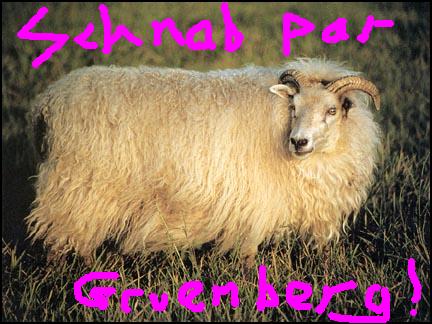Gruenberger species
The moon ram is Gruenberg's national animal, and is known in Rukialkotta as Tak Blomberdun Kassafanion. It has been classified as an endangered species, and there are fewer than 10,000 specimens left in the wild. Hunting the ram is a capital offence, and crimes as seemingly slight as snipping off clips of wool can carry jail sentences. (Thought by some to possess magical charms, moon ram wool, horns and bone are highly-sought after lucky charms, and precious commodities - on the black market.)
The moon ram (ovis lunar) is in fact the male of the moon sheep species, and although ewes are not held in sacred regard, are extended the same legal protection. Its wool is thick and off-white, but can appear pale blue in darker light. Larger and more aggressive than normal rams, it is thought to be unique to Gruenberg. It is a herbivore, eating mainly grasses and bracken, but is also thought to eat a variety of fruit and berries. Its dung, which commoners are legally allowed to collect (providing they avoid harassing the animal), consists of dark, hard pellets, and is largely tasteless and odourless. Loosened with water, it is used to paint decorative religious tokens, or incorporated into jewellery.
The moon ram shown here on this postcard, bearing the greeting 'Welcome To Gruenberg!' in Rukialkotta, is young, probably no more than one year old. Note that large, powerful horns and thick, long wool.
History
The moon ram is believed to have inhabited Gruenberg for thousands of years: a number of references to it are purportedly made in the sacred texts of Wenaism. Its population was estimated at around 40,000 during the third century of the Gruenberg calendar. With tough meat and coarse wool, it is hunted mainly for spiritual reasons.
The moon ram's importance in Gruenberg is mainly on account of the Fable of the Shepherd. In The 192nd Year, two of the seven sacred texts still remained lost, and many believed they would never be found. Then, Gulgon Vonderbat, an impoverished widower who tended moon rams high on Hatash Myari, stumbled into The Holy City with two vast clay urns, inside which were found the ancient scripts. His story was that, tracking down a moon ram, he had come to the thin valley pass where the Four Sages had encountered their first vision of Wena. At that point, the spirit of Wena came down and entered the moon ram, guiding him to a concealed tunnel where the Sages had hidden the final two texts. Ever since then, the animal has been given holy status in Gruenberg. (In an unfortunate epilogue, Vonderbat was executed for attempting to read the Bazhtan writing.)
Once prevalent throughout Gruenberg, diminishing numbers and the relative isolation of the majority of the animals to the far north is usually attributed to over-hunting. However, many zoologists believe the government expansion of industrial agriculture in the late seventh century of the Gruenberg calendar may have played its part. The insecticide Reptacil (4,4,4-trichloromethyl benzyl thioniafrol) was widely sprayed. It is harmless in its own right, but when mixed with other common ammonia-based fertilizers is intensely toxic. Reptacil continues to be used, but in smaller doses as more efficient substances are developed.
OOC: The photograph is in fact from www.icelandicsheep.com.

